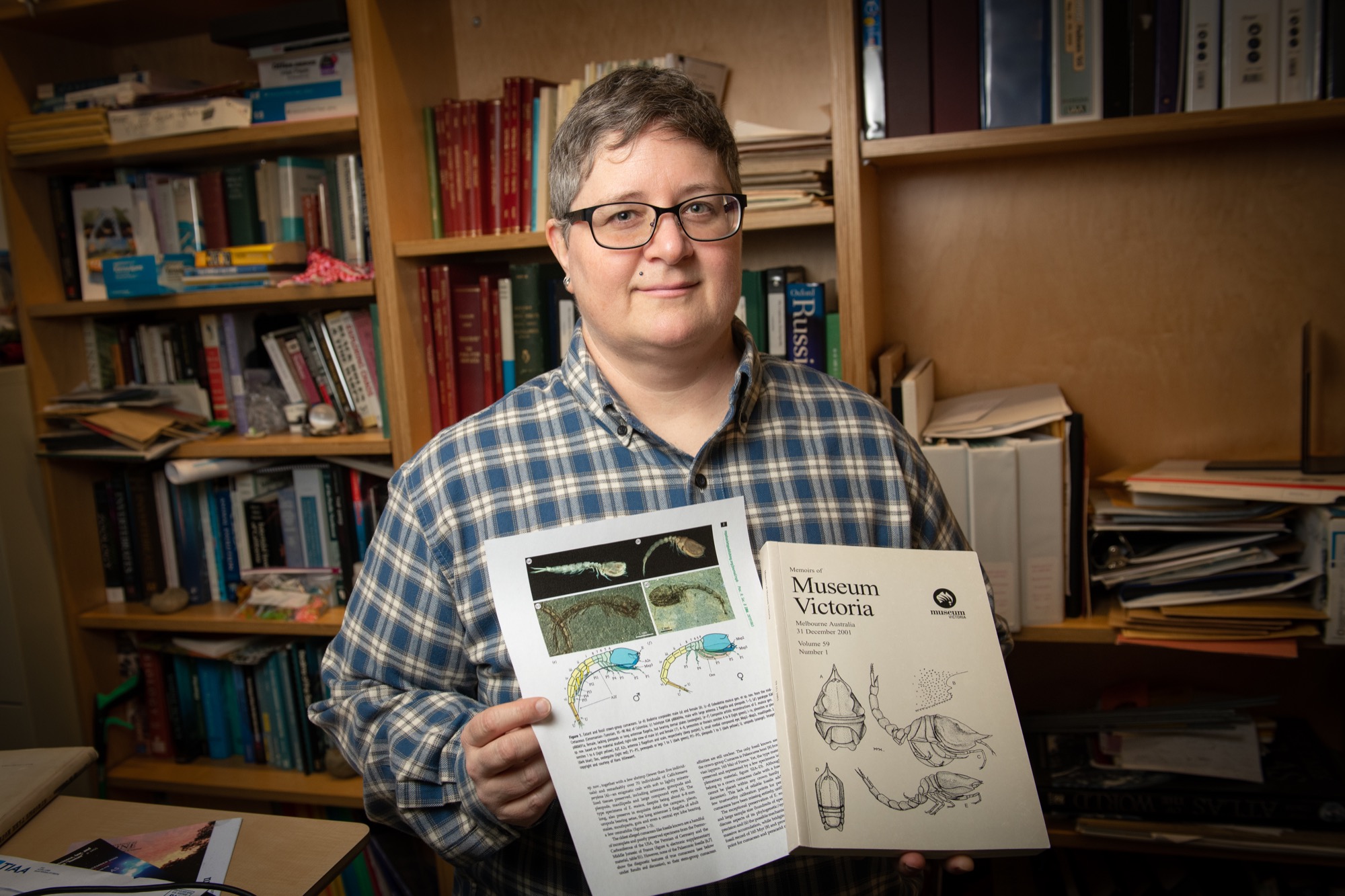Sarah Gerken in the case of the fossilized cumacea
by Catalina Myers |

In the late Cretaceous era, a time in Earth’s geologic history when the climate was warm and much of the planet was covered by shallow inland seas, dinosaurs dominated the mainlands and fantastical prehistoric monsters inhabited the oceans, a less formidable and perhaps more familiar creature existed — cumaceans — also more commonly known as the comma shrimp.
These tiny shrimp abundantly populated the Cretaceous seas roughly 90-95 million years ago and a particular population off the coast of what is now Colombia, South America, left their mark on the world in the form of nearly perfectly preserved fossils. For more than 10 years, Sarah Gerken, a professor in the Department of Biological Sciences and the United States' only cumacea expert, has been analyzing the fossilized specimens in hopes of unlocking their secrets. She and her research partner, Javier Luque, a postdoc at Yale, who unearthed the 200 nearly perfectly preserved specimens, recently released a paper and in November 2019, were featured in Newsweek for the extraordinary discovery.
Cumacea curiosity
Dr. Gerken is one of seven cumacea experts worldwide but stumbled into her specialized field due to circumstance. Growing up she’d always been interested in marine biology and earned both her undergraduate and master’s degrees from the University of California Santa Cruz and her Ph.D. from the University of Maine. It was during her Ph.D. program that her field of study narrowed to crustaceans, particularly cumacea.
“When I was doing my Ph.D., I was funded by a National Science Foundation Partnerships for Enhancing Techniques in Taxonomy grant because there was this recognition that there weren’t many taxonomists left and they weren’t training any new ones,” said Dr. Gerken. Her mentor at the time was one of the few existing cumacean experts and brought her under his wing. Soon after doing her postdoc, Gerken moved to Alaska and began teaching at UAA in 2002. In about 2008, an exciting opportunity in the field of cumacea research knocked on her door.
In 2005, Luque, Dr. Gerken’s current cumacean research partner, was an undergrad student out on a field trip in the Andes Mountains of Colombia and stumbled across the incredibly well-preserved ancient comma shrimp. From the 2019 Newsweek article, Luque said, “It was already late in the afternoon, and I just decided to swing my hammer one more time to check the rocks we were sitting on. It was there when I discovered a layer in the rock with hundreds to thousands of fossils of marine creatures, most of them crustaceans of different shapes and sizes, and among them the comma shrimp that is the focus of our study today."
Since the field of cumacean study is so small, Luque was quickly connected with Dr. Gerken and away they went on a research mystery adventure to not only analyze the fossil specimens but also to theorize what happened to the 200 or so tiny comma shrimp.
But Dr. Gerken and Luque would have to hold off on their excitement for nearly a decade as other projects and life commitments pulled them in new directions and it wasn’t until about a year-and-a-half ago, the pair reunited and were able to make serious headway on the fossils. Dr. Gerken flew out to Yale and spent a week with Luque imaging the tiny shrimp — only measuring between 0.12 to 3 centimeters in length — barely the size of a thumbnail.
They discovered that most of their prized specimens were male and that as far as deaths go the tiny comma shrimp suffered no trauma in the mass event that laid them to rest on the ocean’s floor.
A few theories
Cumaceans are found worldwide from seas in warm tropical locals to the icy cold bays of northern locations like Alaska.
According to Dr. Gerken, cumacea are found in any soft substance — mostly mud or sand — or some type of shale-like environment. She said about 90-95 million years ago Northern South America was a shallow inland sea, an environment where modern cumaceans also tend to thrive.
“They can exist in very big aggregations when there’s food for them,” said Dr. Gerken, pointing to the tidal map and reiterating that Luque’s discovery was not so unusual in where he found them, but the large mass in which they were found in and how amazingly they were well-preserved over the millennia.
Dr. Gerken and Luque’s top theory for the sudden mass death of the comma shrimp?
“Something happened in the water column,” Dr. Gerken said. She explained that a few things could have happened, but most likely, for whatever reason, the water column the shrimp were floating in suddenly lost oxygen — which is known to happen in these types of environments. “It was like they all just gently floated down.”
Which is partly why they’ve been so perfectly preserved for the last 90 million years or so. There was no trauma in their death, which means they weren’t curled up in the fetal position or splayed out trying to escape their imminent deaths. Whatever happened did so instantly and one second they were happily living in the water column and the next they were gently floating down to the seafloor.
For Dr. Gerken, the comma shrimp discovery is thrilling and the type that scientists and researchers dream of. It’s helped fill in some gaps in the geological time table but will also help scientists make predictions about our oceans in the future. For being such a small, seemingly insignificant organism, these tiny shrimp have made a giant impact.
 "Sarah Gerken in the case of the fossilized cumacea" is licensed under a Creative Commons Attribution-NonCommercial 4.0 International License.
"Sarah Gerken in the case of the fossilized cumacea" is licensed under a Creative Commons Attribution-NonCommercial 4.0 International License.

















